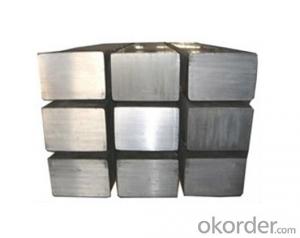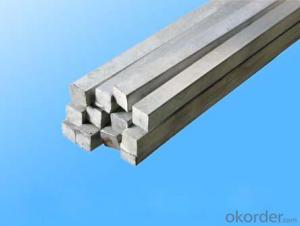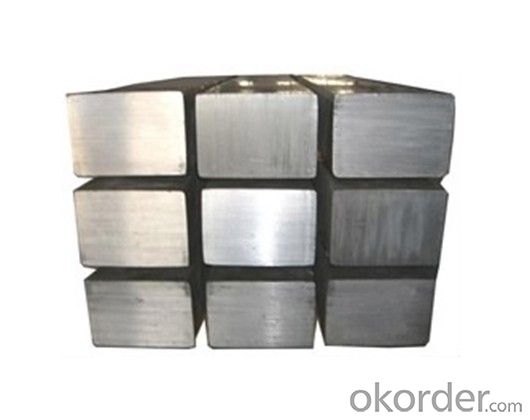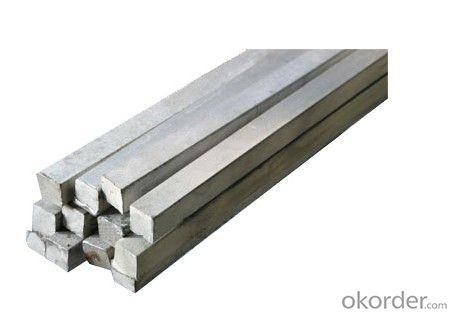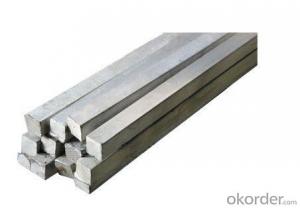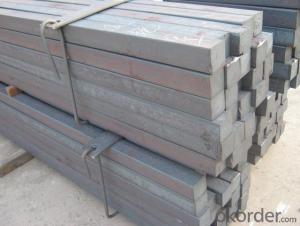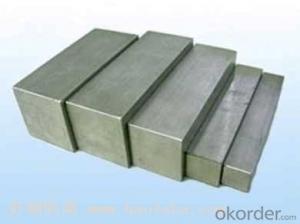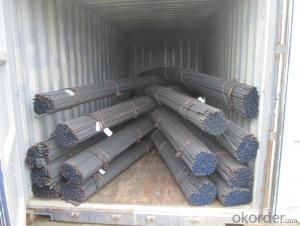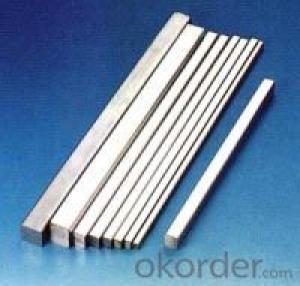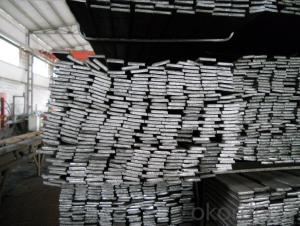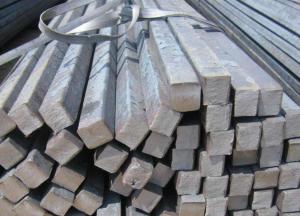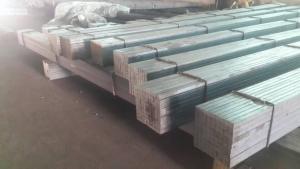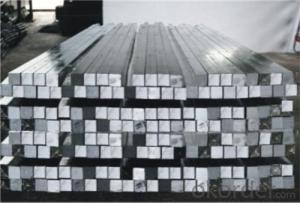Q195Cr High Quality Square Steel Bar
- Loading Port:
- Tianjin
- Payment Terms:
- TT OR LC
- Min Order Qty:
- 1000 m.t.
- Supply Capability:
- 100000 m.t./month
OKorder Service Pledge
OKorder Financial Service
You Might Also Like
Product Description:
Product Description:
In the production of steel products, steel is molded and reshaped with different machinery at different temperatures. One process is steel rolling, which involves metal stock passing through a pair of rolls. Rolling produces flat steel sheets of a specific thickness, and the process is classified according to the temperature at which the metal is rolled. If the temperature of the metal is above its recrystallization temperature, or the temperature at which the grain structure of the metal can be altered, then the process is termed as hot rolling. If the temperature of the metal is below its recrystallization temperature, the process is termed as cold rolling.
Like cold rolling, cold drawing is performed at room temperature, but instead of producing a flat object like a coke can, cold drawing makes steel into the form of a wire like the spokes of a wheel or a paper clip. To start the process, Steel is usual hammered and rolled so that it can be fit through a die; a tool that turns the steel mass into a wire. The room temperature steel is pulled through the die which reshapes it into a thinner shape while maintaining the same volume. It is similar to the idea of syrup flowing out of a bottle through a tube in that it changes shape but not volume, but instead of squeezing the metal, it is pulled out. In order to get the wire down to the right diameter, it usually requires more than one pass through different dies.
Colddrawn steel, steel covered carbon steel, excellent carbon steel, alloy structural steel, carbon tool steel, spring steel, bearing steel, tool steel, cold heading steel, free cutting steel, martensite stainless steel; products include all kinds of shapes round, square steel, hexagonal, flat steel and other conventional products, including various special-shaped steel products. In all types of colddrawn steel industry has been widely used, these areas include automotive, machine tools, furniture, standard parts, textile machinery, agricultural machinery, military industry and other industries.
The total assets of more than 40 million, as of the end of 2010 with fixed assets of 34 million, with 60 tons from 5 tons a chain drawing machine 10 sets, horizontal and inverted coiled wire drawing machine 5 sets, steel and plate production line of blasting, high-power ham stove, various straightening machine and cold rolling mill and other major equipment.
Usage/Applications
-The Square Bar is normally used as structure steel.
-Row material for other structure steel like steel angles, channels, I-beams, H-beams, etc…
Packaging & Delivery
-Packing Detail: The products can be packed in bundles by steel wires.
-Marks: We make tag marks and color marks. The tag marks with white background and red company logo will be tied up to each bundle of the products. The information is usually including basic information of products and company and other information requested by customers. As for color marks, we will paint both ends of bundles to make sure that it w
-Delivery Detail: 30~45 working days after receive buyer’s T.T. or L/C.
ill be more convenient for customers to distinguish them from other products.
- Q: What are the common applications of a steel square in masonry work?
- A steel square is commonly used in masonry work for tasks such as measuring and marking angles, checking for squareness and straightness, and laying out precise and accurate lines and cuts. It is also useful for determining the correct sizes and lengths of bricks or blocks and ensuring proper alignment during construction.
- Q: Can a steel square be used for checking the levelness of shelves?
- No, a steel square cannot be used for checking the levelness of shelves. A steel square, also known as a framing square, is primarily used in carpentry and woodworking to measure and mark angles and to ensure the accuracy of right angles. It is not designed or suitable for checking the levelness of shelves. To check the levelness of shelves, a level tool such as a spirit level or a laser level should be used. These tools are specifically designed to determine if a surface is perfectly horizontal or level. They provide a much more accurate and reliable measurement for ensuring the levelness of shelves.
- Q: How does a steel square assist in measuring and marking angles?
- A steel square assists in measuring and marking angles by providing a straight edge and a right angle that can be used as a reference. The square has a long blade that can be placed against a surface to measure its alignment, and a shorter tongue that can be used to mark right angles. By aligning the square's blade with a desired angle or using the right angle of the square to create perpendicular lines, accurate measurements and markings can be made.
- Q: What are the measurements on a steel square?
- The measurements on a steel square typically include a straight edge measuring 24 inches, a centering head, a protractor, and a ruler with both metric and imperial measurements.
- Q: Can a steel square be used for cutting or shaping materials?
- Certainly! A steel square possesses the capability to cut and shape various materials. Although its primary function lies in measuring and verifying right angles, the straight edges and corners of a steel square can also serve as a guide for cutting or shaping materials like wood, metal, or plastic. By offering a robust and accurate reference point, the steel square guarantees precise cuts or shapes. Nevertheless, it is crucial to acknowledge that the steel square does not function as a cutting tool but rather aids in upholding straight lines and right angles while cutting or shaping.
- Q: What is a steel square?
- A steel square is a versatile measuring and layout tool used in carpentry and woodworking. It consists of a flat metal blade with different measurements and angles marked on each side. Its main purpose is to ensure accurate right angles and precise measurements during various construction tasks.
- Q: How do you use a steel square to mark angles?
- To use a steel square to mark angles, you first need to understand its components. A steel square, also known as a framing square or carpenter's square, is a versatile tool with two main parts: the body and the tongue. To mark angles, start by placing the body of the square against one edge of the material you are working with, such as a board or piece of metal. Ensure that the body is aligned with the edge so that it lies flat against it. Next, extend the tongue of the square along the other edge of the material, making sure it is parallel to the body. The tongue can be adjusted by loosening the screw that connects it to the body, allowing you to slide it to the desired position. Once the square is properly positioned, you can begin marking the angle. To do this, use a pencil or a scribe to draw a line along the inner edge of the tongue. This line will represent the angle you are marking. If you want to create a right angle, simply align the body and tongue of the square so that they form a 90-degree angle. Then, draw a line along the inner edge of the tongue to mark the angle. For other angles, you can adjust the position of the tongue according to the degrees you want to mark. Steel squares typically have degree markings etched onto the body, allowing you to easily set the desired angle. By using a steel square, you can accurately mark angles on various materials, ensuring precise cuts and measurements in your woodworking or metalworking projects. Remember to double-check your measurements and always use caution when working with sharp tools.
- Q: Can a steel square be used for checking the squareness of a workbench leg?
- Yes, a steel square can be used for checking the squareness of a workbench leg. A steel square is a versatile tool that is commonly used in woodworking and construction to ensure accurate right angles and squareness. To check the squareness of a workbench leg, you can place the steel square against the leg and the surface it is supposed to be perpendicular to. By aligning the square with the leg and checking if the edges are perfectly perpendicular, you can determine if the leg is square or if it needs adjustments. The steel square provides a reliable and precise measurement for checking squareness in various applications, including workbench legs.
- Q: How do you use a steel square to determine the angle of a compound routing template cut?
- In order to determine the angle of a compound routing template cut using a steel square, the following steps should be followed: 1. Prepare the steel square: Before starting, ensure that the steel square is clean and free from any debris or damage. Place it on a flat surface, making sure it is properly aligned. 2. Align the template: Position the compound routing template on top of the steel square, ensuring a snug fit against the square's edges. Align the template in such a way that the desired cut aligns properly with the square's edges. 3. Examine the alignment: Observe the template's alignment against the square's edges. Pay attention to the markings and numbers along the square's edges. These markings represent the angles formed by the square. 4. Determine the angle: By observing where the template aligns with the markings on the square, you can determine the angle of the compound routing template cut. For instance, if the template aligns with the 45-degree marking on the square, then the angle of the cut is 45 degrees. 5. Apply the angle for cutting: Once the angle has been determined using the steel square, transfer that angle to your workpiece or cutting tool. This will serve as a guide to achieve an accurate and precise compound routing template cut. It is important to keep in mind that the accuracy of the angle measurement using a steel square relies on the precision of the square itself. Therefore, it is advisable to use a high-quality steel square and ensure that it is properly calibrated before attempting to use it for angle measurements.
- Q: Can a steel square be used for checking the squareness of a router table insert plate?
- Indeed, the squareness of a router table insert plate can be assessed utilizing a steel square. This trusty and precise instrument serves as a dependable means of ascertaining right angles and validating the perpendicularity of the insert plate with respect to the table surface. Placing the steel square against the plate's edges and ensuring a seamless fit devoid of gaps or overlaps enables one to determine whether the plate is flawlessly square or necessitates adjustments.
Send your message to us
Q195Cr High Quality Square Steel Bar
- Loading Port:
- Tianjin
- Payment Terms:
- TT OR LC
- Min Order Qty:
- 1000 m.t.
- Supply Capability:
- 100000 m.t./month
OKorder Service Pledge
OKorder Financial Service
Similar products
Hot products
Hot Searches
Related keywords
